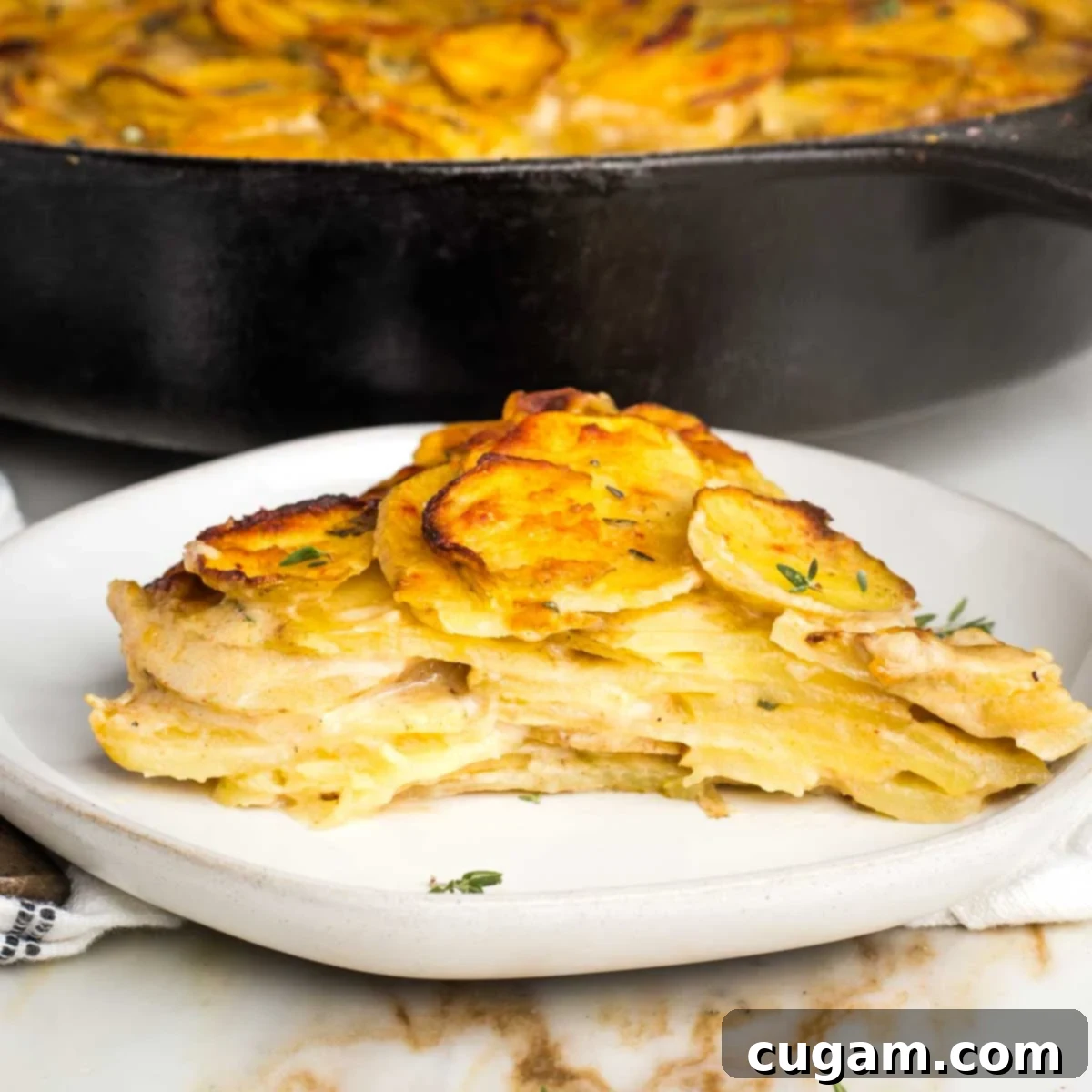Dairy-Free Scalloped Potatoes: The Ultimate Creamy, Vegan, & Gluten-Free Side Dish
Prepare to be amazed by these incredible Dairy-Free Scalloped Potatoes! Imagine layers of tender, pillowy-soft potatoes, lovingly enveloped in a rich, dreamy, and entirely plant-based white sauce. This isn’t just a side dish; it’s a culinary masterpiece that brings decadent perfection to your table. Whether you’re planning a show-stopping Thanksgiving feast, a memorable holiday dinner, or simply want to elevate a weeknight meal, these creamy scalloped potatoes are a guaranteed success that will delight everyone, even the most discerning palates.
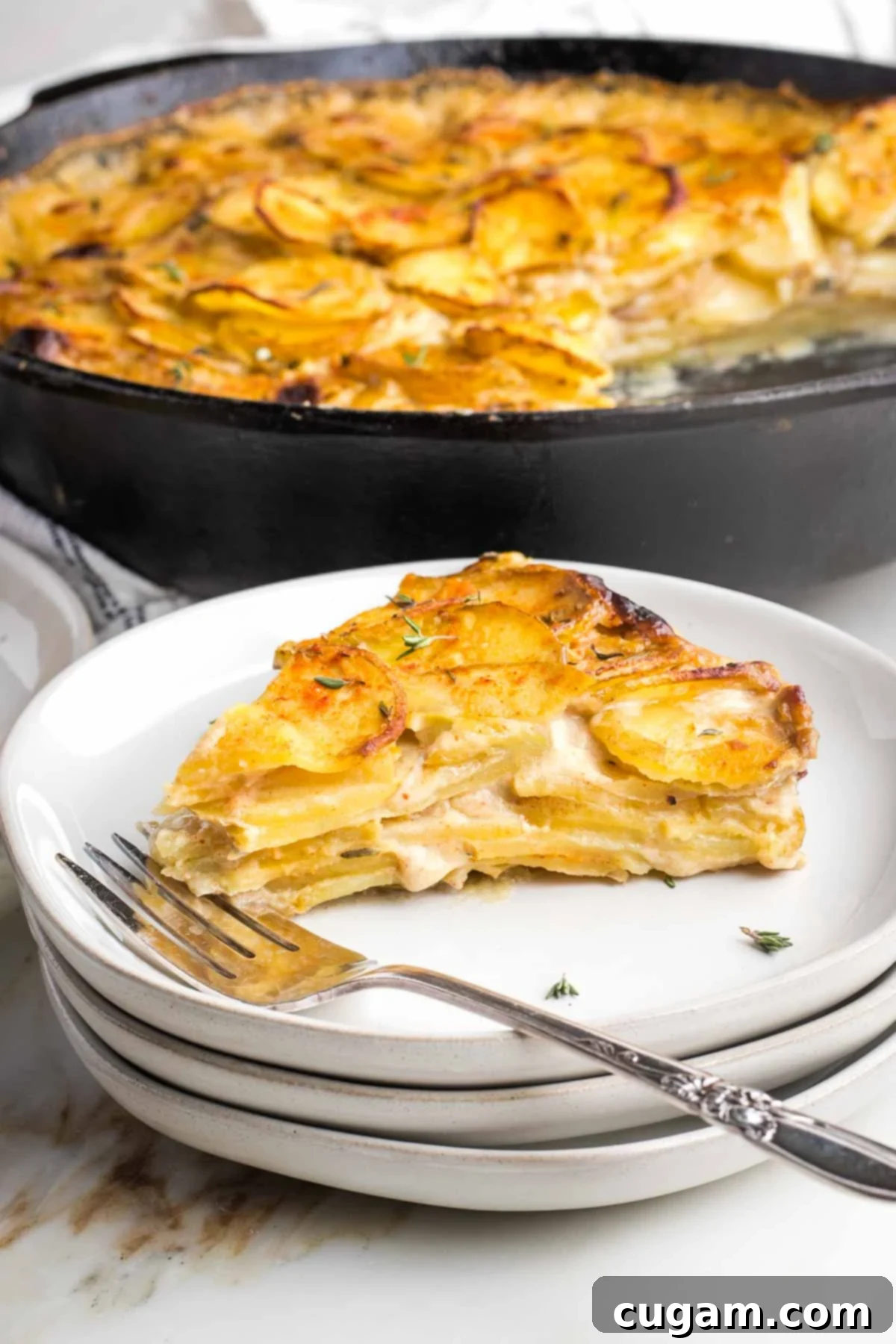
You’re going to fall in love with these gluten-free and dairy-free scalloped potatoes. They are incredibly delicious, surprisingly easy to make, and yes, completely vegan, ensuring that everyone at your table can enjoy this comforting classic. This recipe captures the heart and soul of traditional scalloped potatoes, but it’s thoughtfully lightened up with simple, wholesome ingredients and a clever technique. Our promise to you? NO MUSHY, BLAND, OR BORING POTATOES. Ever. Get ready for a side dish that’s bursting with savory flavor and delightful texture!
Going dairy-free doesn’t mean sacrificing taste or richness, and this fabulous potato side dish is living proof! We’ve meticulously crafted this recipe to ensure every forkful is savory, satisfying, and utterly delicious. Follow along to create dairy-free scalloped potatoes that will truly knock your socks off and become a staple in your recipe repertoire.
The Secret to Our Creamy Dairy-Free Sauce
Like all truly great scalloped potato recipes, the magic lies in a wonderfully flavorful white sauce. For this vegan version, I’ve ingeniously adapted my beloved dairy-free bechamel sauce. By making a few savory seasoning adjustments and incorporating a generous amount of rich veggie broth, the results are nothing short of stunningly delicious. My husband, a tough critic, enthusiastically rated this dish 11 out of 10 stars and even gave it his seal of approval for our Thanksgiving Menu. That’s a high compliment!
One common question is the difference between scalloped potatoes and an au gratin. The primary distinction is the cheesy topping found on an au gratin dish. While our scalloped potatoes focus on the creamy, cheesy *flavor* without actual dairy cheese, if you’re specifically craving that melted, bubbly cheese crust, I highly recommend trying my creamy vegan parsnip au gratin for truly cheesy satisfaction, completely dairy-free!
Why Choose Dairy-Free and Vegan Scalloped Potatoes?
Opting for dairy-free and vegan alternatives offers a host of benefits, both for your health and for inclusivity at the dinner table. This recipe ensures that guests with lactose intolerance, dairy allergies, or those following a plant-based lifestyle can fully enjoy a classic comfort food without compromise. Furthermore, by using wholesome plant-based ingredients, we’ve created a dish that’s often lighter on digestion while still providing deep, satisfying flavors. It’s a win-win for everyone!
Ingredients and Substitutions for Perfect Scalloped Potatoes
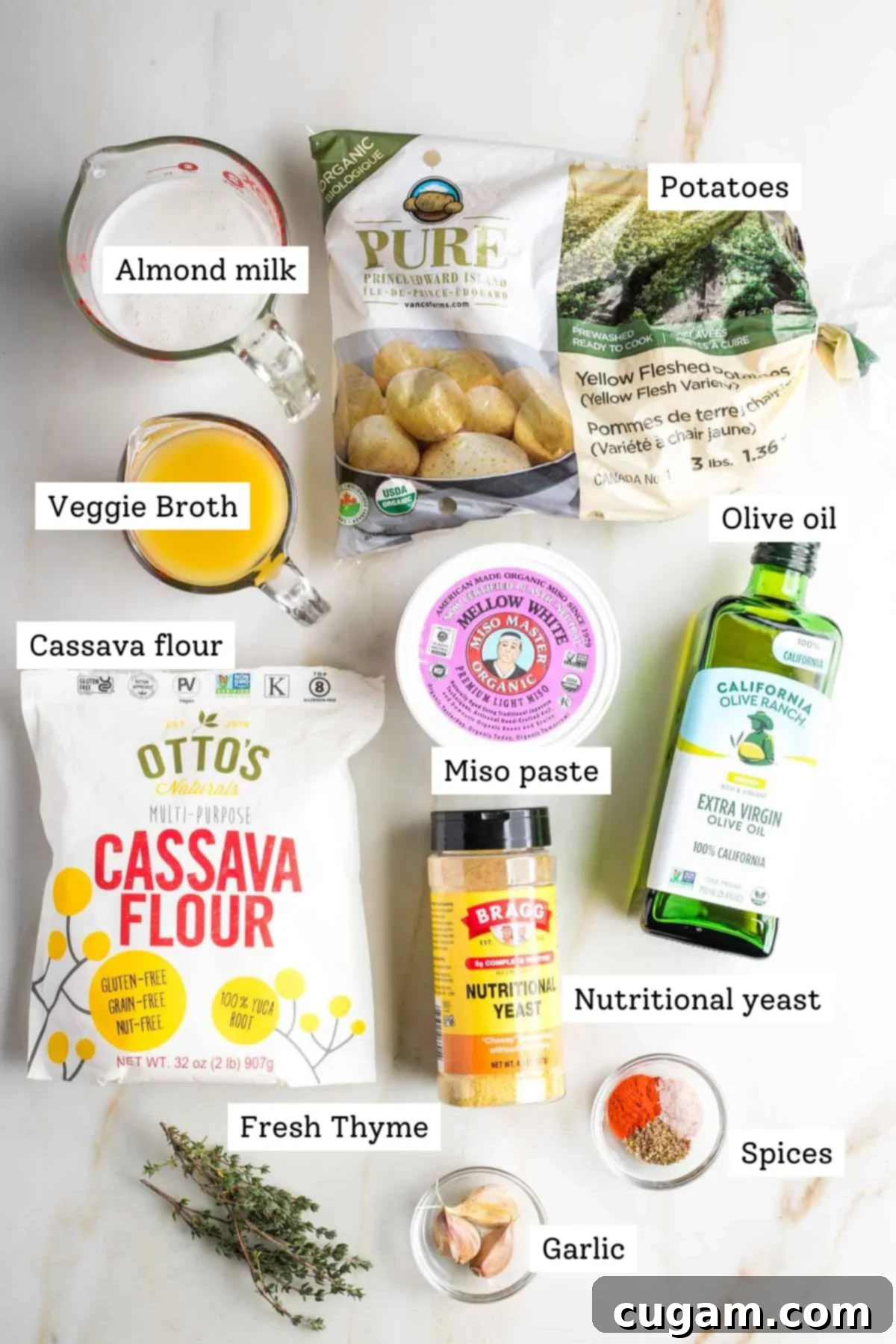
- Potatoes: The type of potato you choose significantly impacts the final texture. For the creamiest scalloped potatoes, opt for starchy varieties like Yukon Gold, King Edward, or Russet potatoes. If you prefer a dish where the potato slices hold their shape a bit more, creating a lovely layered look, Red Bliss potatoes are an excellent choice. No matter the variety, ensure they are fresh and firm.
- Plant Milk: This recipe is incredibly versatile when it comes to plant-based milk. Almost any variety will work beautifully, so feel free to choose one that aligns with your dietary preferences. Soy, oat, and cashew milk are all fantastic options as they tend to have a relatively neutral flavor that won’t overpower the delicate notes of the sauce. Avoid overly sweetened or flavored milks.
- Miso Paste: This is our secret weapon for an incredible umami boost! Miso paste, a fermented soybean paste, adds a depth of savory flavor that mimics the richness often associated with dairy and even ham in traditional scalloped potatoes. It’s a game-changer for vegan recipes. A light (shiro) or mellow white miso works best here.
- Nutritional Yeast: Affectionately known as “nooch,” nutritional yeast provides a subtle, cheesy, and nutty flavor that perfectly complements the savory sauce. It’s an optional ingredient, but highly recommended for that classic scalloped potato “vibe.” If you’re not a fan, you can simply omit it without compromising the core flavor.
- Spices: A simple yet effective blend of a touch of salt, freshly ground black pepper, and paprika is all you need. The paprika not only adds a hint of warmth but also contributes a beautiful golden hue to the dish.
- Fresh Herbs: I personally love the earthy aroma and flavor of fresh thyme, which is surprisingly easy to grow year-round in a sunny window. Excellent substitutions include fresh parsley, basil, or oregano. If fresh herbs aren’t available, don’t worry! A tablespoon of dried Italian seasoning will provide a wonderful aromatic profile.
- Veggie Broth: For the best flavor, I highly recommend using my easy homemade veggie broth recipe. You can prepare it in advance and store it in 1-cup increments in the freezer for convenience. If buying store-bought broth, be sure to read the label carefully. Many commercial broths are high in sodium, so adjust or omit the added salt in this recipe accordingly to prevent your dish from becoming too salty.
How to Make These Creamy Vegan Scalloped Potatoes
Making these dairy-free scalloped potatoes is a rewarding process, starting with the luscious white sauce and culminating in beautifully layered, perfectly baked potatoes. Follow these steps for a flawless result:
First, prepare your miso paste: set aside a couple of tablespoons of the plant milk (or veggie broth) and use a fork to thoroughly mix in the miso paste until it forms a consistent, smooth texture. This pre-dilution is key to ensuring it disperses evenly into your sauce later, preventing lumps and maximizing flavor.
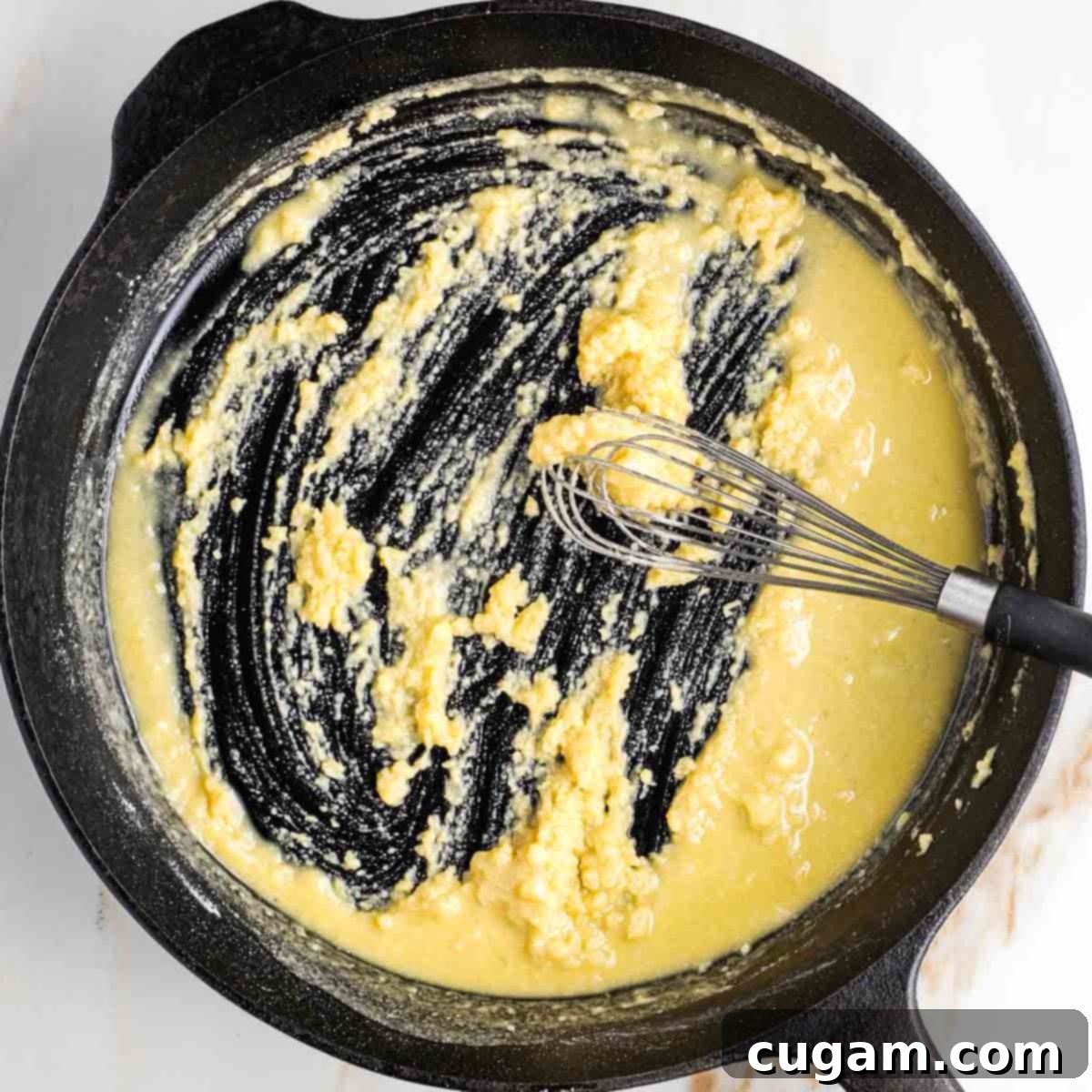
You’ll begin by creating a flavorful roux, which forms the base of our creamy sauce. Heat the olive oil in a sturdy cast iron skillet over medium-low heat. Once warm, sprinkle on the cassava flour. Immediately begin whisking continuously until a thick, smooth paste forms. This process lightly toasts the flour, developing a deeper flavor and ensuring a lump-free sauce.
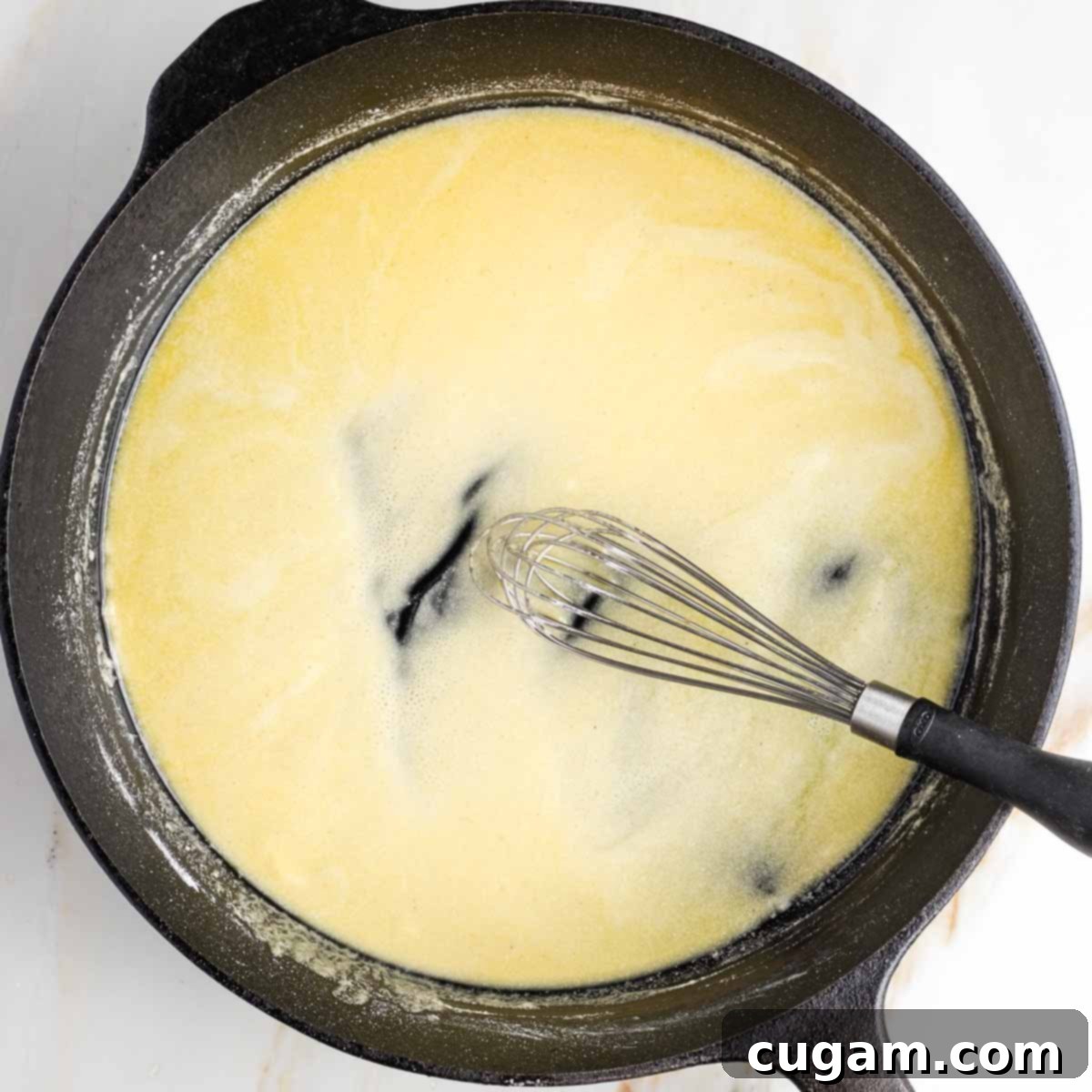
Next, add about 2 tablespoons of veggie broth to the roux and continue to whisk vigorously. The mixture will thicken quickly. Then, add the finely grated garlic and stir constantly for about 30 seconds until its aromatic fragrance is released. Be careful not to burn the garlic.
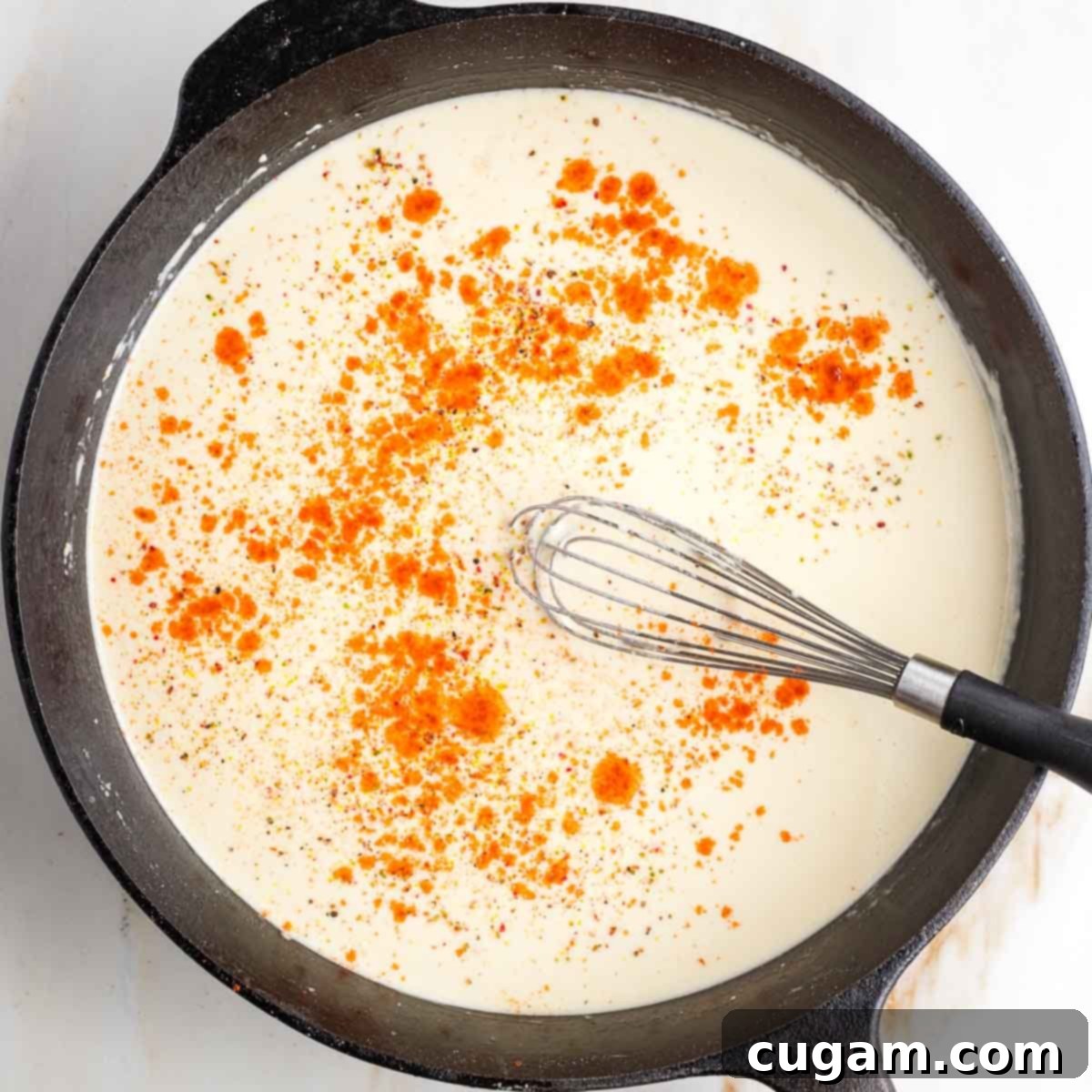
Now, gradually build your creamy sauce. Continue adding the remaining broth and plant milk, about ¼ cup at a time, whisking thoroughly after each addition. You’ll notice the white sauce alternating between getting thicker and then thinner as you incorporate more liquid. This is perfectly normal. Once all the liquid is incorporated, stir in the prepared miso paste mixture, along with the paprika, salt, and pepper.
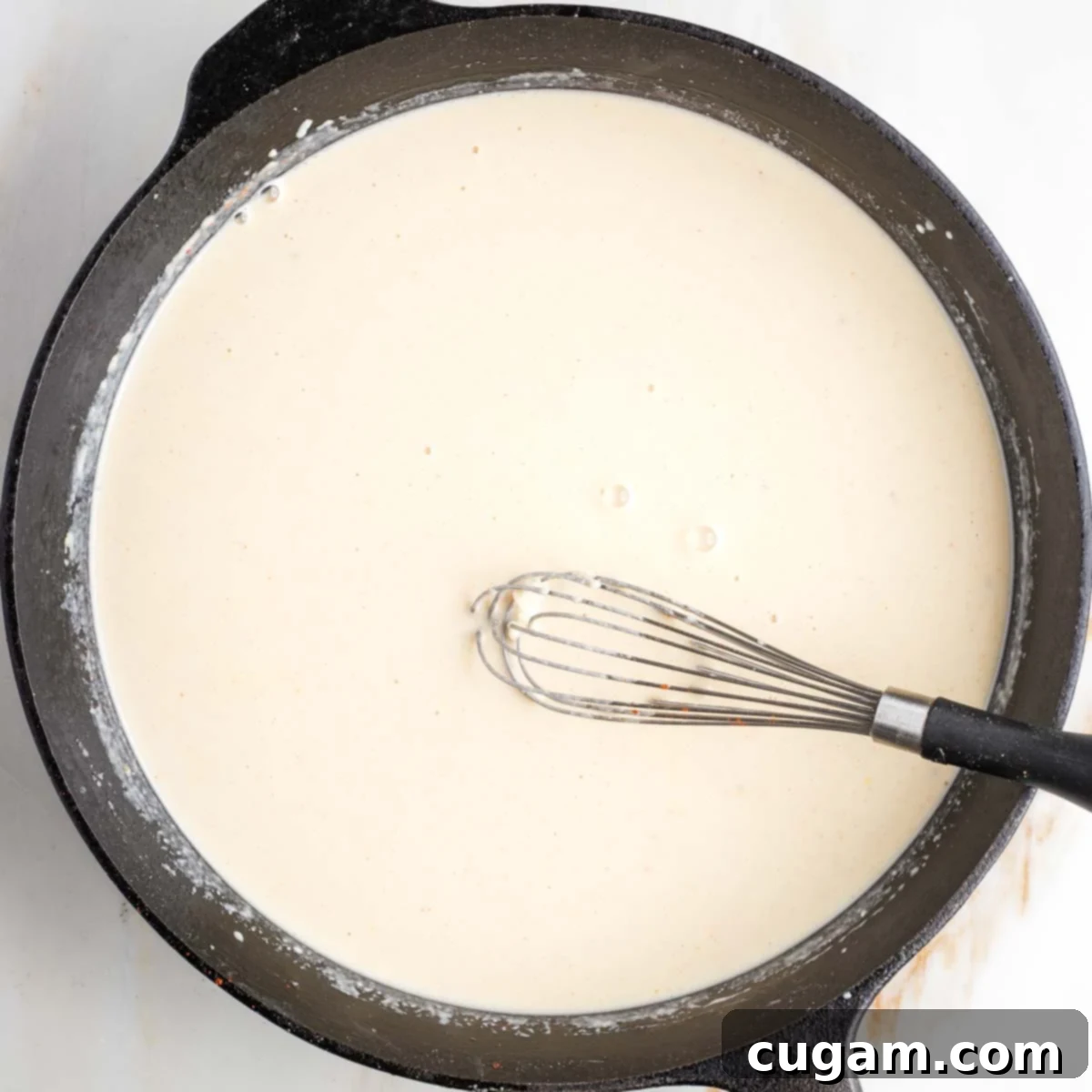
Whisk everything until it’s seamlessly incorporated and the sauce is wonderfully thick and creamy. It should still have a somewhat drippy consistency, which is absolutely perfect for coating and cooking the potato slices to tender perfection. Pour this exquisite sauce into a separate bowl or a large measuring cup and set aside. You should have approximately 2 ¾ cups of this luscious, savory white sauce.
Preheat your oven to 350 degrees Fahrenheit (175 degrees Celsius) to ensure it’s ready for baking.
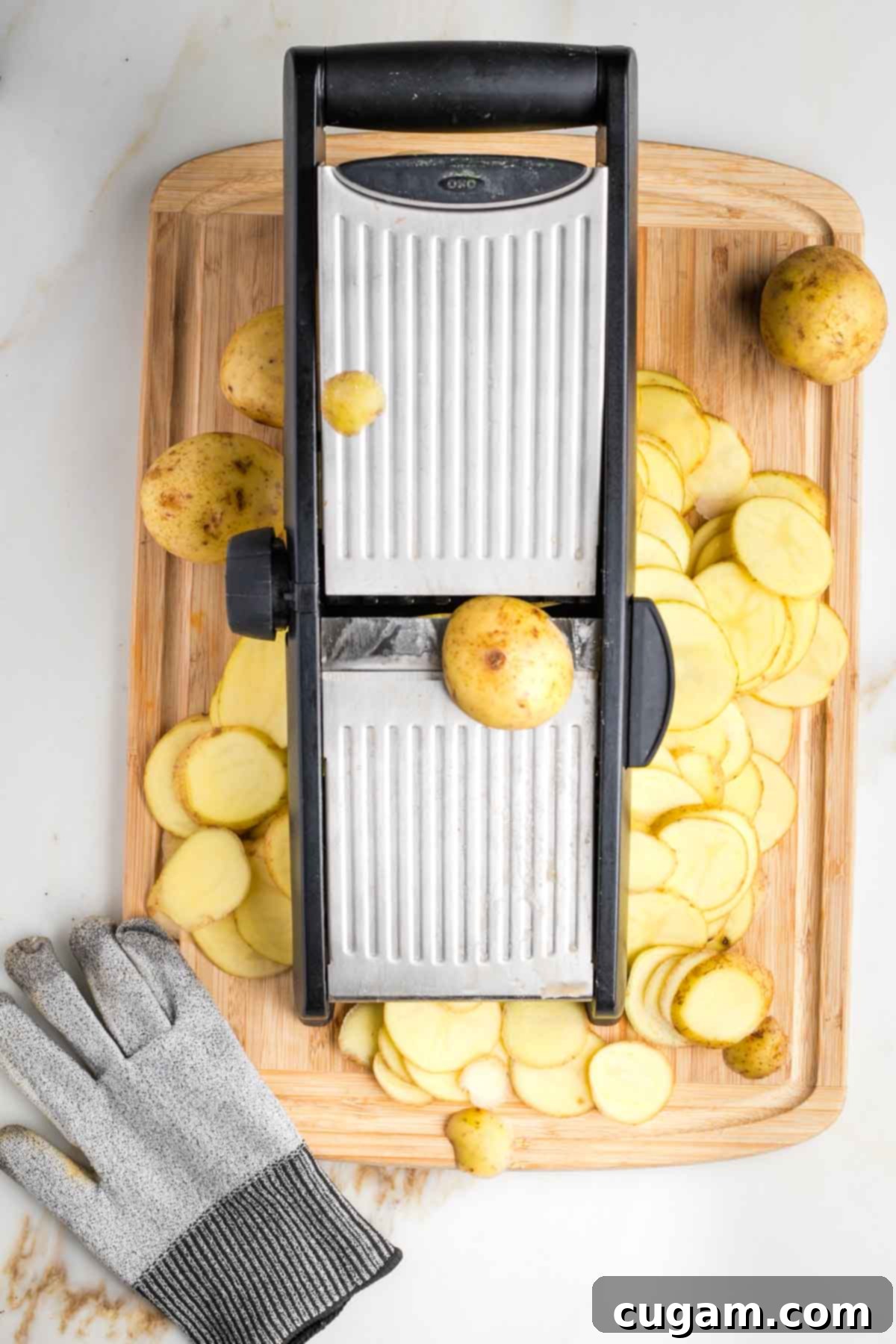
Thoroughly wash and scrub your potatoes, removing any dirt or debris. There’s no need to peel them; the skins add a rustic charm and extra nutrients. The easiest way to achieve uniform ⅛-inch thickness is to use a mandolin slicer or a food processor with a slicing attachment. Of course, you can also meticulously cut them by hand, though it will take a bit more time. It might look like a mountain of potatoes once sliced, but trust the process – they will all fit beautifully into your skillet or baking dish.
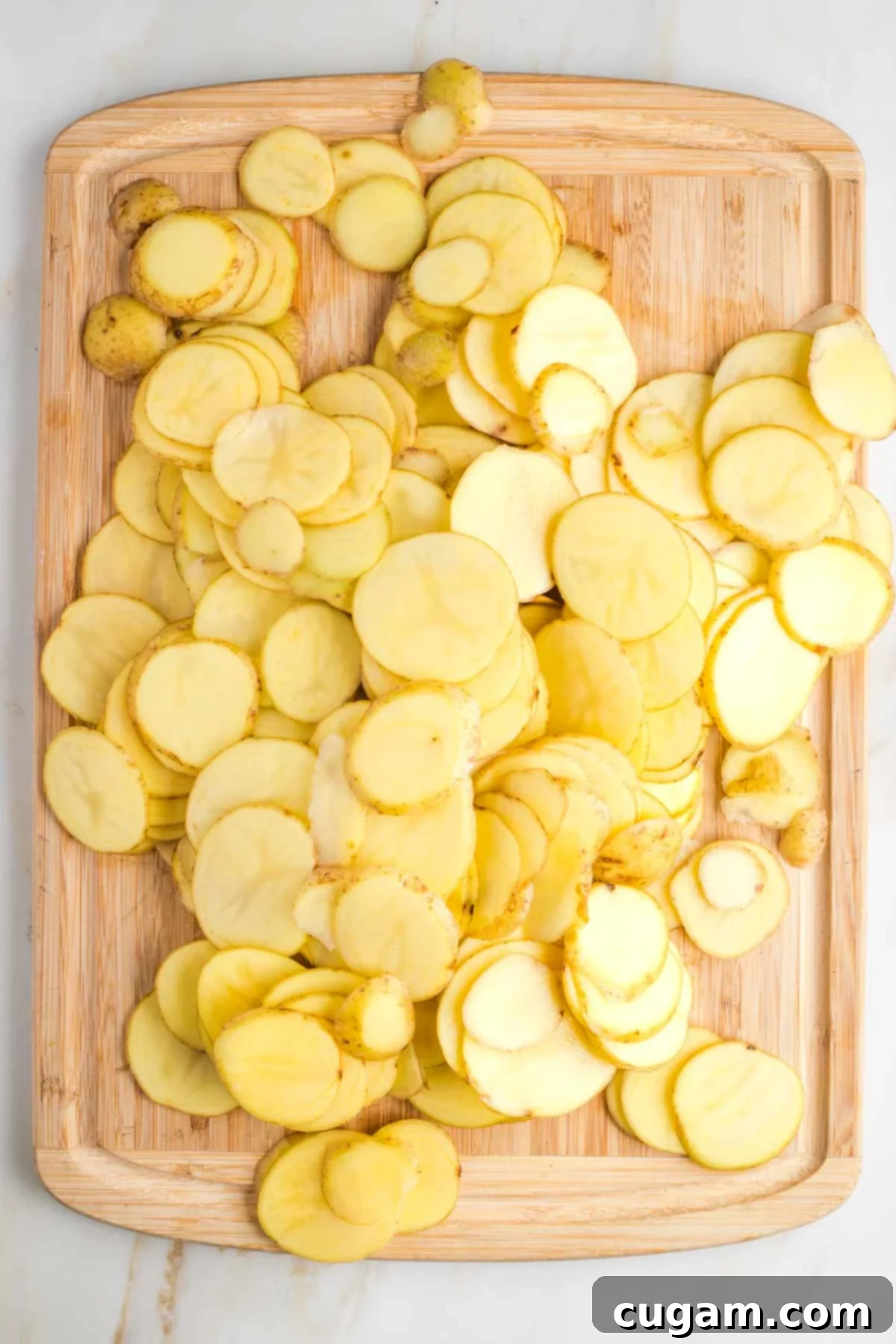
Once sliced, arrange your potatoes. This “shingling” technique is crucial for achieving that perfect, even bake. Think of it like laying shingles on a roof! A slight overlapping, cross-hatch pattern works best, allowing the sauce to seep between every slice. This ensures each potato piece cooks to tender perfection on the inside while the top layer develops a delightful crispness.
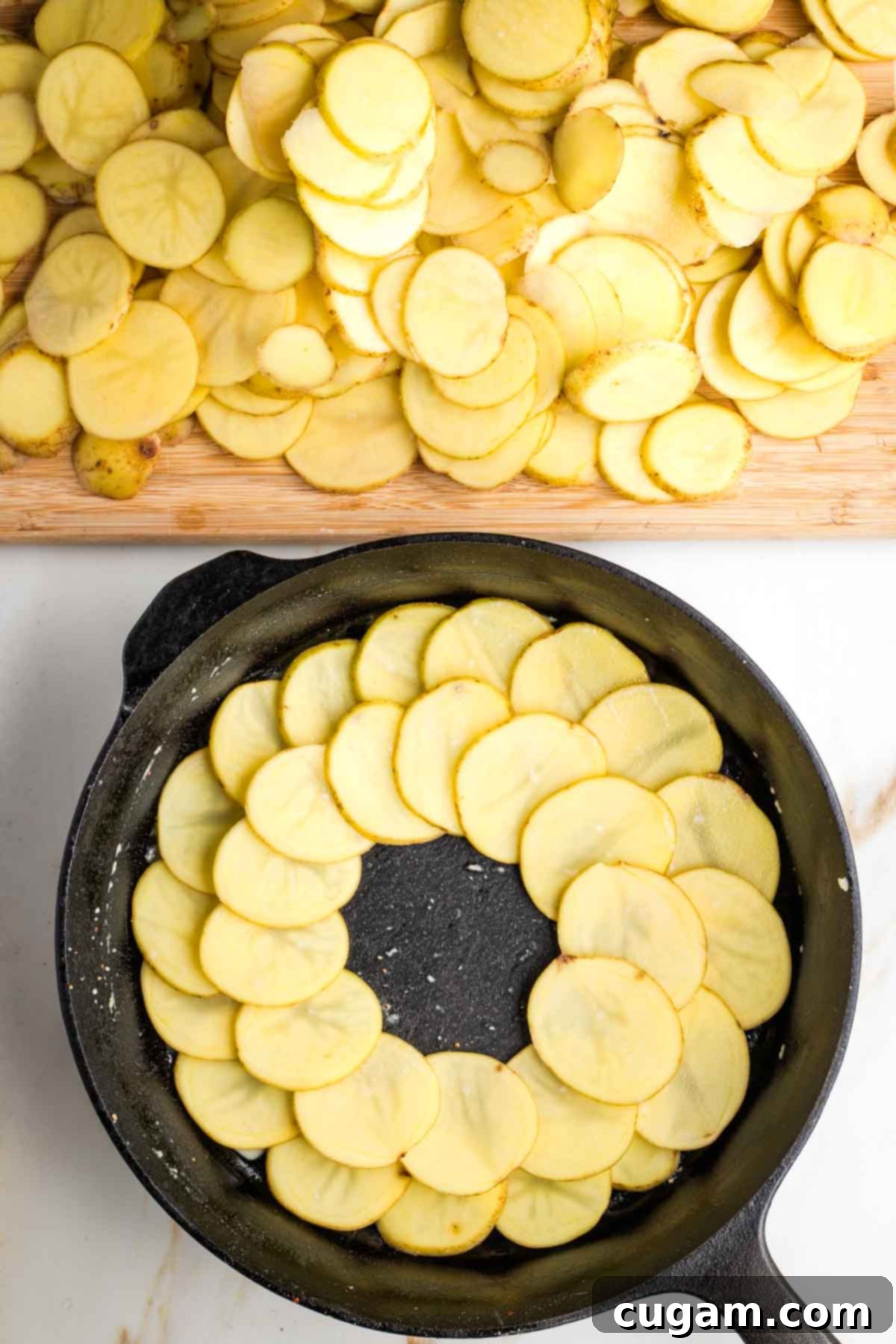
Use the same cast iron skillet you used to prepare the sauce – fewer dishes, more flavor! Begin the bottom layer by placing individual potato slices against the sides of the skillet, slightly overlapping them. Once you complete that first outer circle, start on the next layer, continuing to overlap in all directions as you work your way towards the center of the pan. This creates a beautiful and functional pattern.
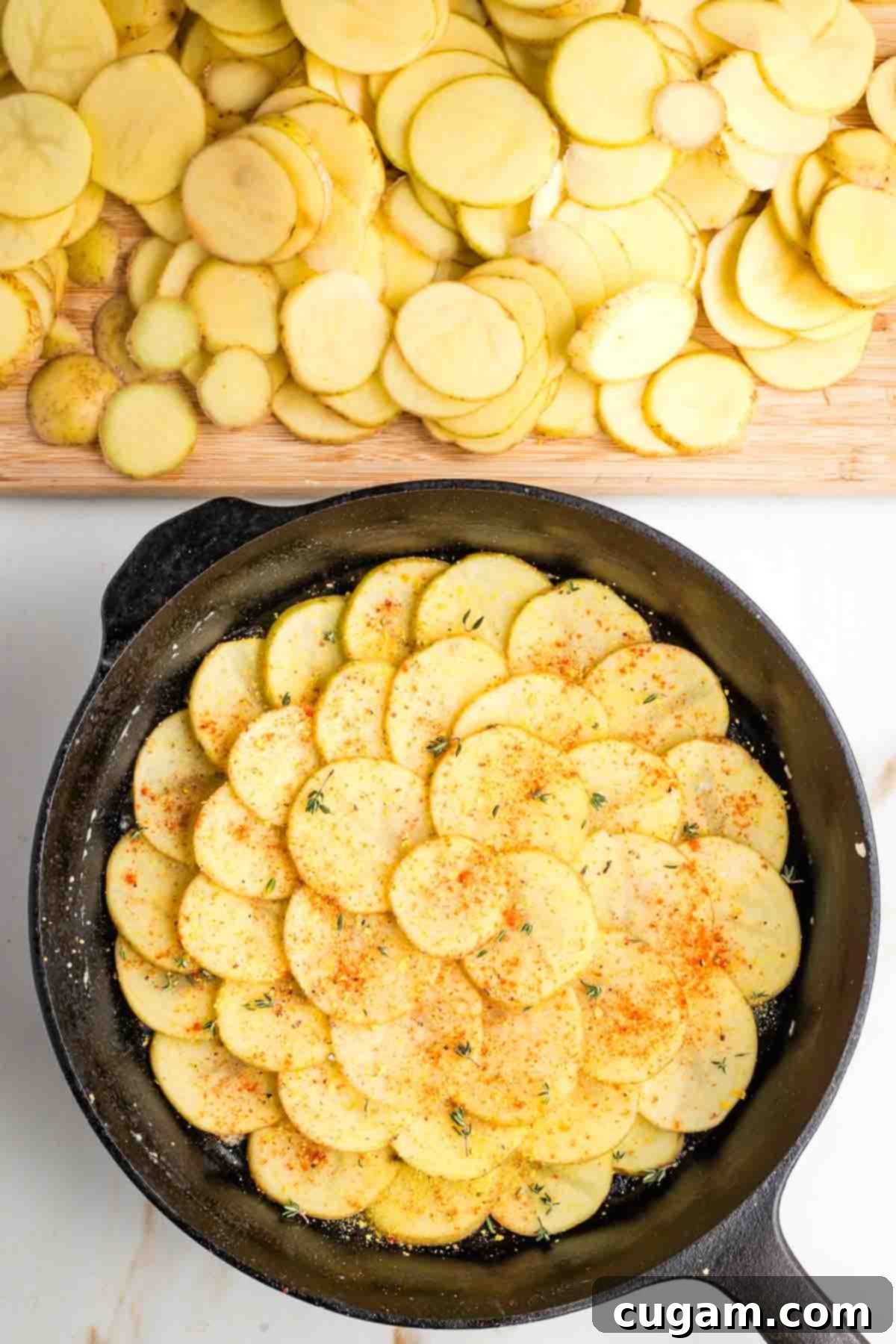
Once you reach the center with your first layer of potatoes, it’s time to season! Sprinkle a generous pinch of the remaining salt, pepper, paprika, and a handful of fresh herbs (like thyme) onto the potatoes. These seasonings will infuse flavor throughout the layers as the dish bakes, ensuring every bite is delicious.
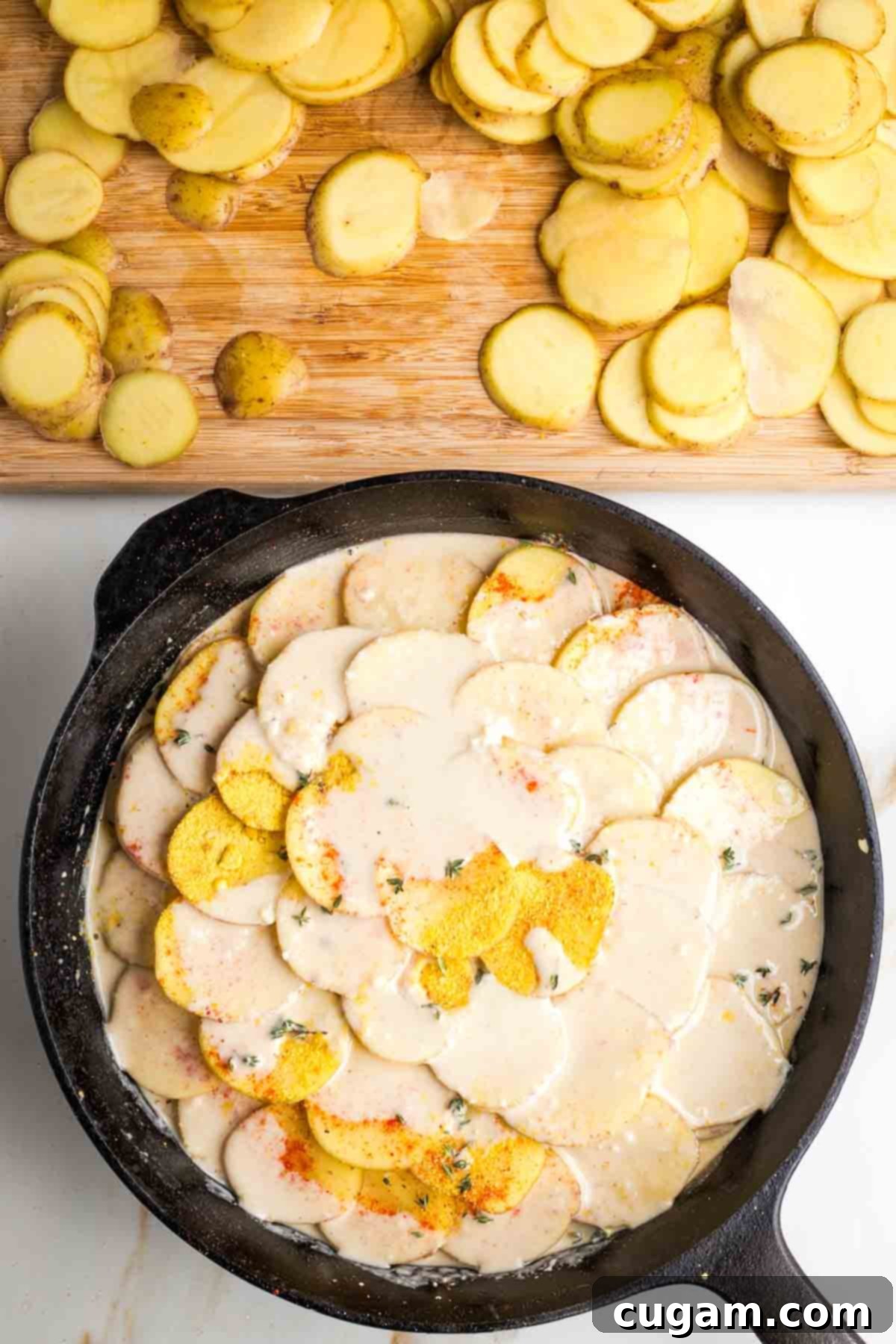
To complete the first layer, carefully pour about ¾ cup of your creamy, savory white sauce evenly over the arranged potatoes. This sauce will begin to seep down, coating the slices below. Finish this layer with a light sprinkle of nutritional yeast for an added hint of cheesy flavor. And there you have it – layer one is complete, a foundation for the deliciousness to come!
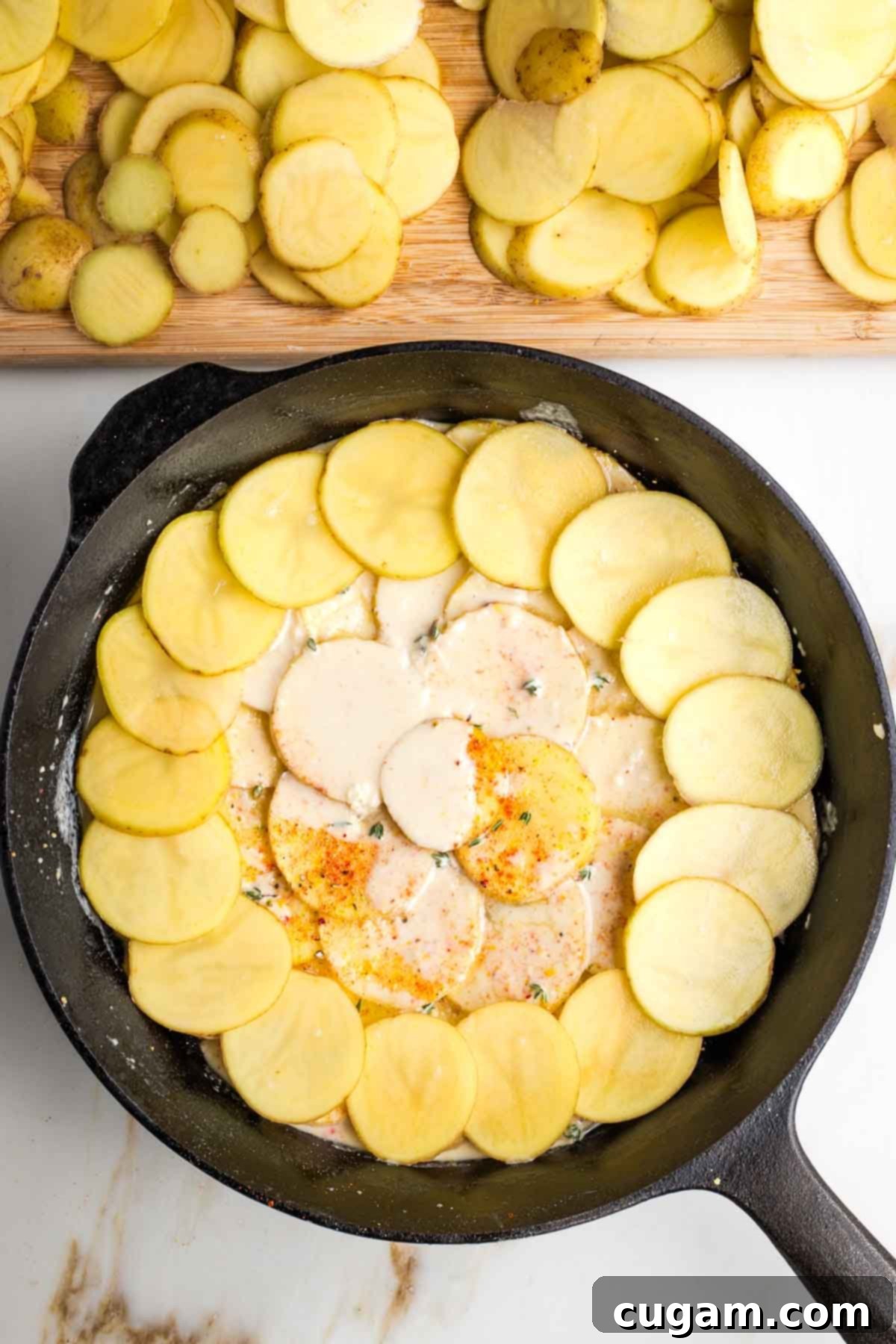
Now, repeat the layering process! Start a new layer of the overlapping spiral potato pattern, once again placing potatoes on the outside edge first and gradually working your way towards the center with circular layers. Continue to layer with potatoes, remaining spices, more sauce, and nutritional yeast until all your ingredients have been used up. The final layer should have a generous amount of sauce.
Covering the dish is an essential step for success. Use aluminum foil, or if your skillet or baking dish comes with a snug-fitting cover, that works too. Covering the potatoes for the initial 45 minutes of baking allows them to steam gently and cook all the way through to tender perfection, ensuring no raw or undercooked sections. After this steaming period, removing the cover and increasing the oven temperature allows the top layer to achieve the most fabulous, golden-brown crispy scalloped potato crust imaginable!
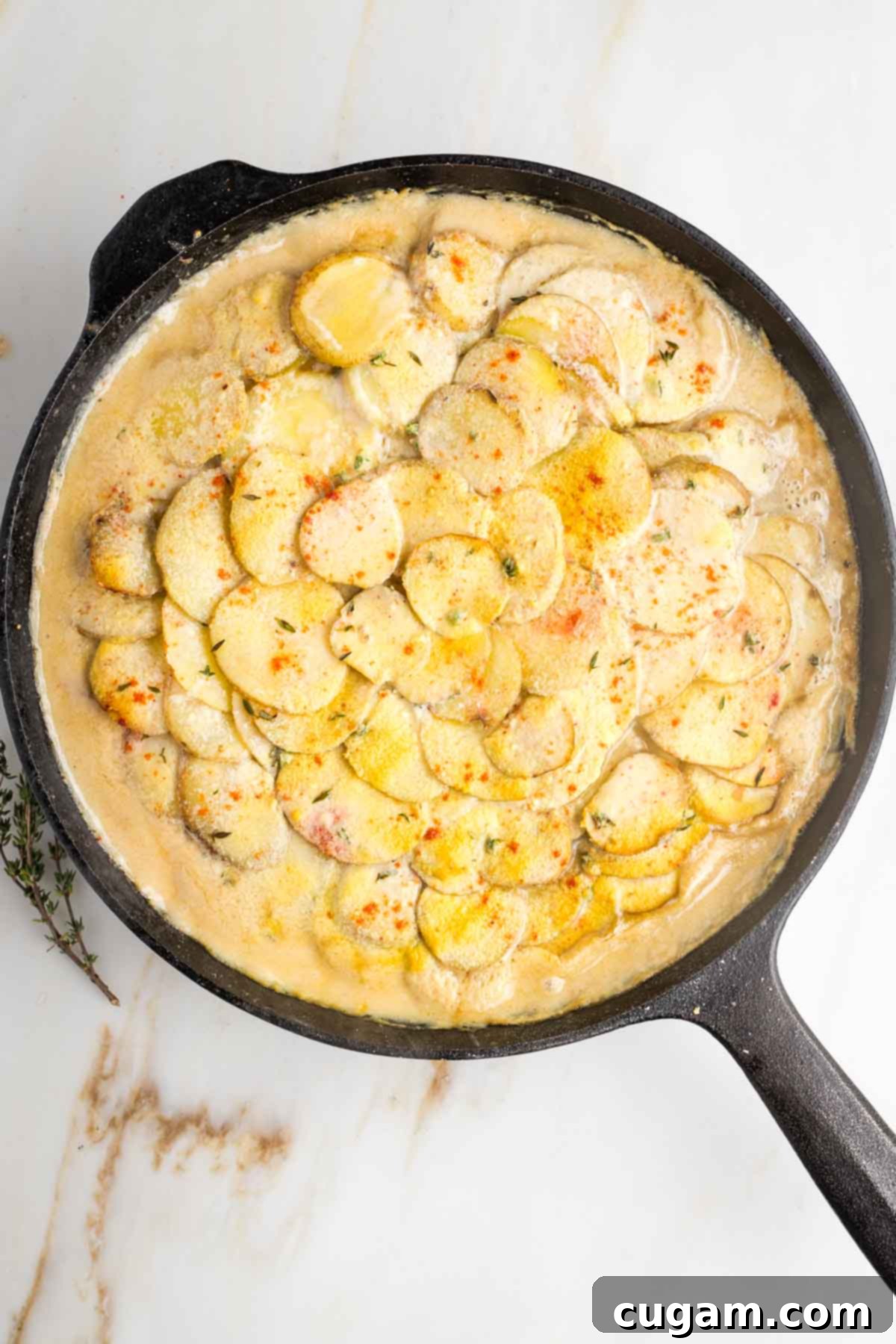
The very top layer of your scalloped potatoes should be coated with the remaining sauce and a final sprinkle of nutritional yeast. Cover the skillet tightly with foil and bake in your preheated 350-degree oven for 45 minutes. When you peek, the sauce should be bubbling vigorously, and the potatoes beneath should be well on their way to tenderness.
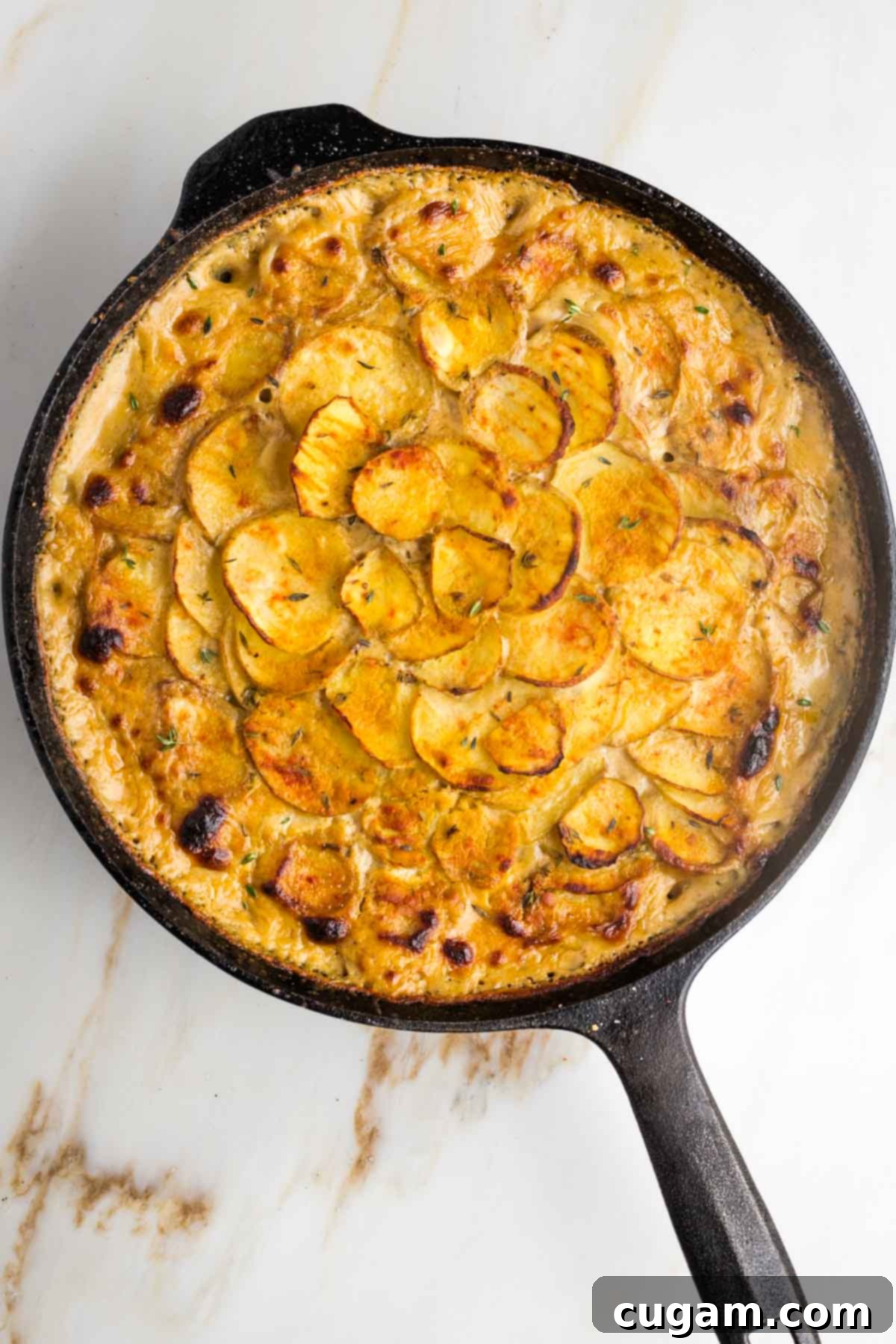
Now for the grand finale: remove the foil and increase the oven temperature to 450 degrees. Place the uncovered skillet back into the oven for a final 15 minutes. During this time, the top layer will transform, becoming beautifully golden brown with enticing crisp spots. To ensure the potatoes are fully tender, pierce them with a fork. If there’s any resistance, simply return the dish to the oven for another 5 minutes, checking again until they are perfectly cooked through.
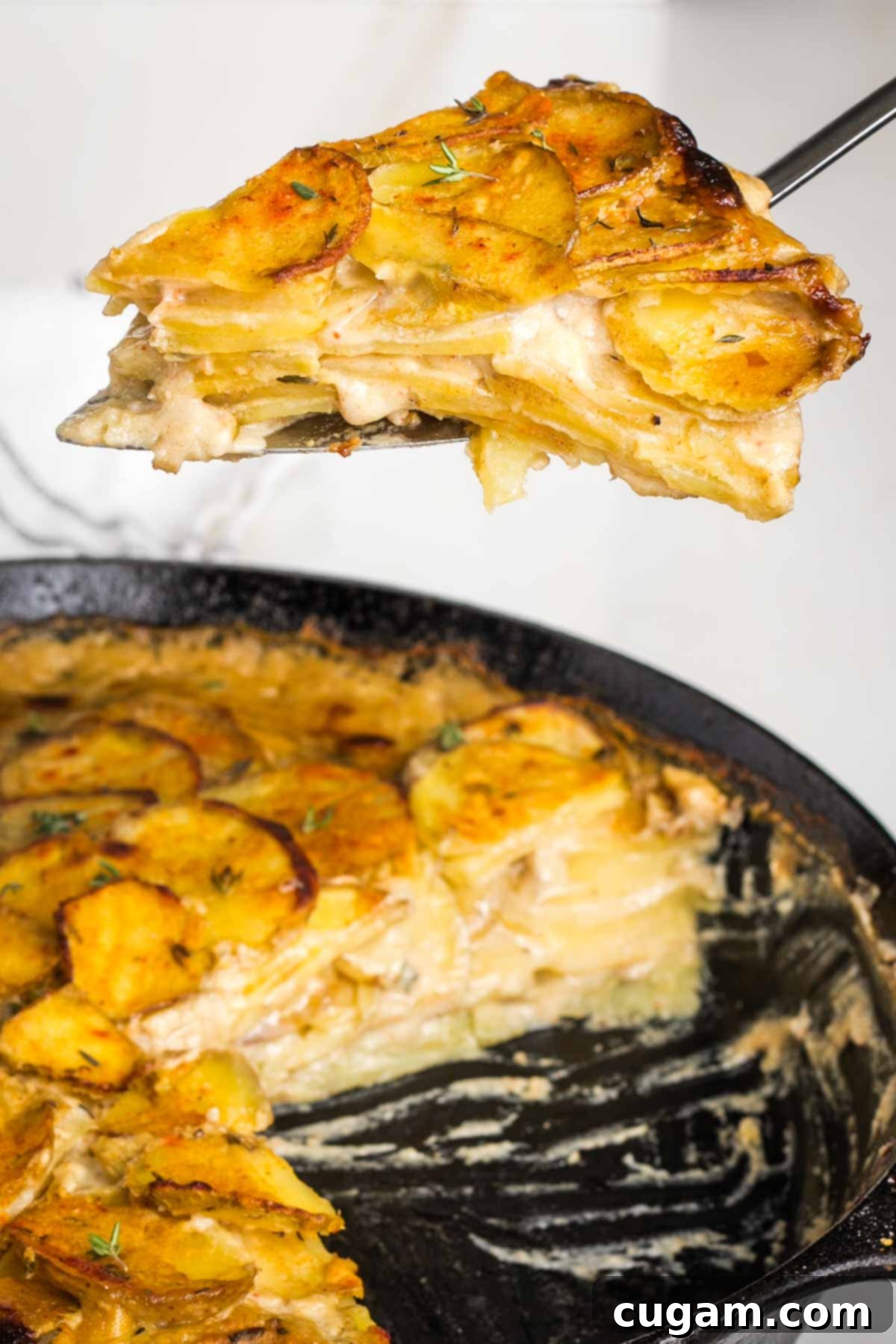
Once baked to perfection, allow the scalloped potatoes to rest for a few minutes before serving. Then, use a sharp knife to cut into neat slices, or simply scoop out generous portions with a large spoon. The aroma alone will have everyone eager to dig in!
Debra’s Pro Tips for Dairy-Free Scalloped Potatoes
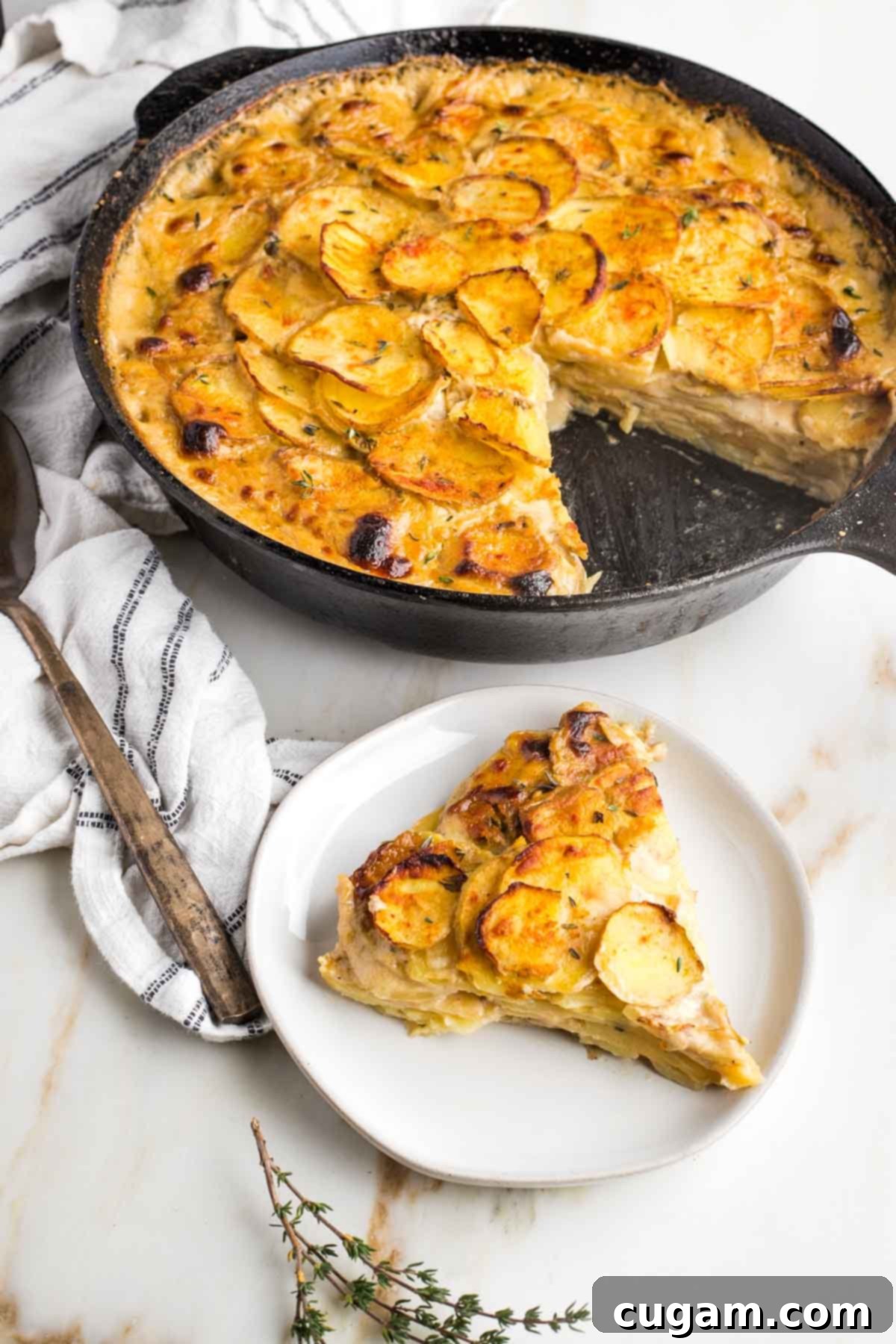
- Patience with the Sauce: The creamy white sauce is the heart of this dish. It will typically take between 5-10 minutes to reach the perfect consistency. Maintain the heat on medium-low and exercise patience as it thickens. The key is to add your liquid slowly, alternating between broth and milk, whisking thoroughly after each small addition to ensure a smooth, lump-free sauce. Don’t rush this step!
- Dilute Miso Paste: My “secret” ingredient, miso paste, adds an incredible depth of savory, umami flavor that replaces the richness of dairy or even ham in traditional recipes. However, it’s crucial to dilute the miso paste in a couple of tablespoons of plant milk or broth *before* adding it to the main sauce. This ensures it dissolves completely and incorporates evenly, rather than clumping.
- Baking Dish Alternative: While a cast iron skillet provides excellent heat retention and a rustic presentation, you can absolutely use a standard 9×13 inch baking dish. When layering, instead of spirals, simply arrange the potato slices in neat rows across the dish, then create a second layer in the opposite direction. You’ll achieve the same delicious results!
- Versatile Serving: These dairy-free scalloped potatoes are incredibly versatile. They make an unforgettable side dish for Thanksgiving or any holiday celebration. They’re also a fabulous addition to a special brunch menu. What’s more, they are excellent for meal prep; in fact, many people find they taste even better when reheated the next day, as the flavors have more time to meld.
- Achieving Crispy Edges: To get those truly golden, crispy edges, ensure your cast iron skillet (or baking dish) is properly oiled. The initial covered bake softens the potatoes, while the final uncovered bake at a higher temperature creates that irresistible crust. Don’t skip the higher heat for the last 15 minutes!
Serve, Store, Reheat
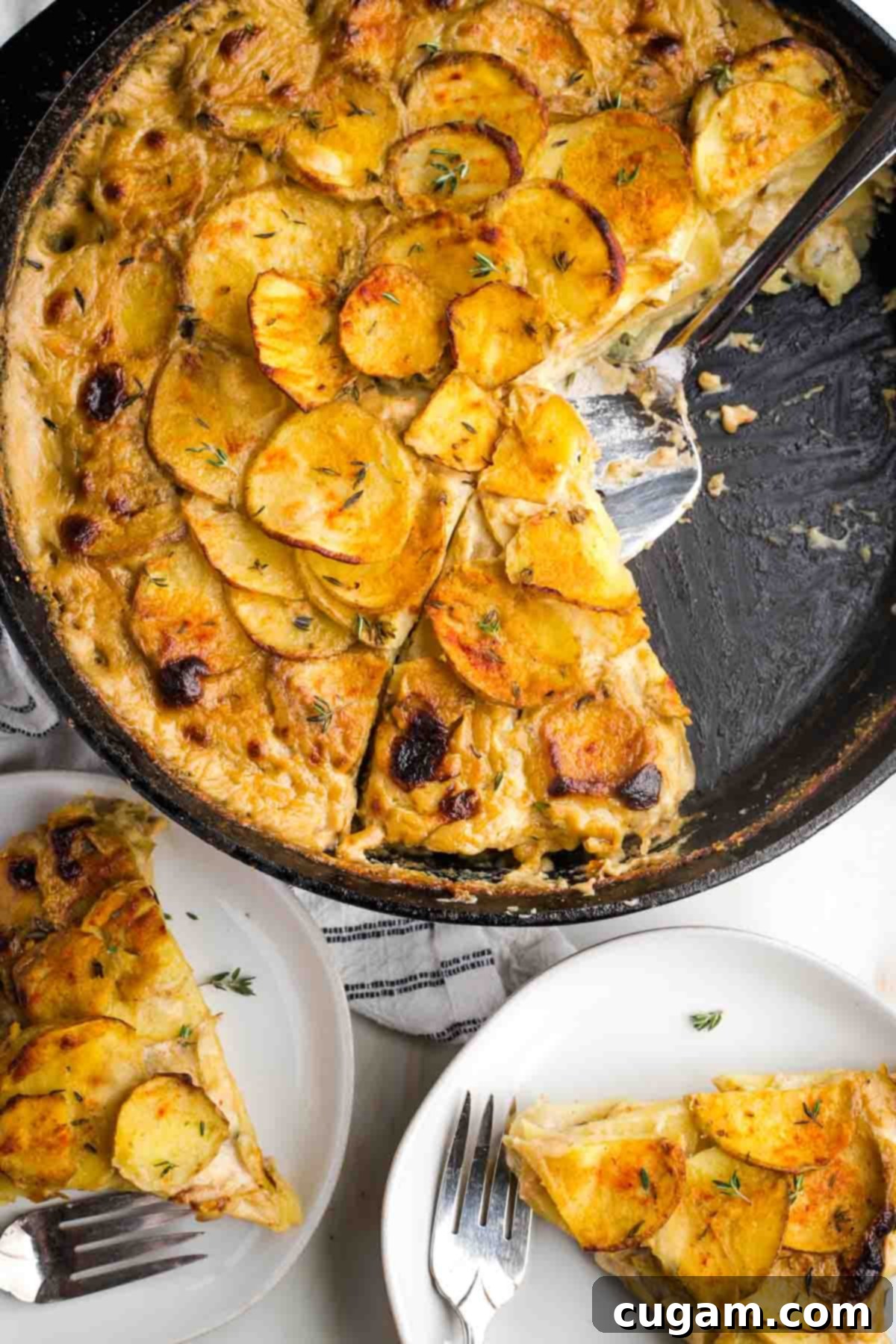
- Serve: These vegan scalloped potatoes are a magnificent accompaniment to a variety of main dishes. Pair them with BBQ tofu and veggies, a hearty vegan meatloaf, savory miso mushrooms, or tofu satay. For a complete and balanced meal, add a fresh, vibrant simple arugula salad to cut through the richness.
- Store: To keep any leftovers fresh and delicious, allow the scalloped potatoes to cool completely to room temperature. Then, cover them tightly with plastic wrap or transfer them to an airtight container. Store in the refrigerator for up to 5 days.
- Reheat: For best results, reheat in a preheated 325-degree Fahrenheit (160 degrees Celsius) oven for about 30 minutes, or until thoroughly heated through and bubbling. If you’ve brought the dish to room temperature before reheating, it will likely be ready in approximately 20 minutes. Avoid microwaving if you want to maintain some crispness on the top.
- Freezing: These dairy-free scalloped potatoes freeze beautifully, making them an excellent option for future meals or holiday planning. If you plan on freezing, bake them in a freezer-safe 9×13 inch or square baking pan (either 8 or 9 inch). Allow the entire dish to cool completely, then cover tightly with multiple layers of foil and a layer of plastic wrap to prevent freezer burn. They will last up to 3 months in the freezer. To reheat, thaw the dish overnight in the refrigerator, then bake as suggested above until heated through and the top is re-crisped.
Did you know commenting and rating recipes is one of the best ways to support your favorite food bloggers? If you made this recipe, please consider a five-star rating below and leave a comment sharing your experience. Also, we’d love to see your creations! Please share your photos on Instagram by tagging me @dkhealthcoach and using the hashtag #debraklein! Your feedback and shares truly make a difference.
📖 Recipe
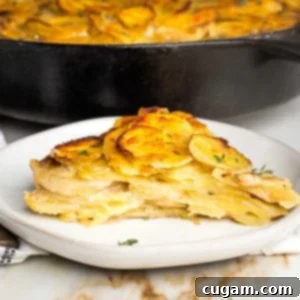
Dairy-free Scalloped Potatoes (gluten-free)
Rate this Recipe
Pin Recipe
Equipment
-
10-inch Cast Iron Skillet
-
Mandoline Slicer
-
OXO Good Grips 11-Inch Balloon Whisk
Ingredients
- 3 lbs. yellow potatoes
- ¼ cup olive oil
- ¼ cup cassava flour
- 3 cloves garlic finely grated
- 1 ½ cups almond milk
- 1 cup vegetable broth
- 1 teaspoon sea salt divided
- 1 teaspoon paprika divided
- ¼ tsp black pepper divided
- 1 tablespoon miso paste
- 4 sprigs fresh thyme
- 1 tablespoon nutritional yeast
Instructions
Creamy Vegan White Sauce
-
Set aside a couple tablespoons veggie broth (or almond milk) and dissolve 1 tablespoon miso paste into the broth using a fork until smooth. This ensures even flavor distribution.
-
Heat olive oil in cast iron skillet over medium-low heat. Sprinkle in the cassava flour and whisk constantly until it forms a thick paste, cooking for 1-2 minutes to toast the flour.
-
Pour in a couple tablespoons almond milk and continue whisking until fully incorporated. Then add the grated garlic and stir constantly for about 30 seconds until fragrant.
-
Alternate between adding broth and milk, about ¼ cup at a time, whisking well after each addition until the liquid is fully incorporated and the sauce begins to thicken. Continue this process until all the milk and broth are used up. Finally, pour in the prepared miso mixture along with half the paprika, half the salt, and half the pepper.
-
Whisk everything well until the sauce is smooth, thick, and creamy. Pour the finished white sauce into a separate bowl or measuring cup. You’ll have just under 3 cups of delicious sauce ready for layering.
Layer Potatoes
-
Wash potatoes and scrub them thoroughly; peeling is not necessary. Use a mandolin, food processor, or a sharp knife to cut the potatoes into uniform ⅛-inch thickness.
-
Using the same skillet (no need to clean it!), begin layering. Lay a circle of overlapping potato slices against the outer edge of the skillet. Continue layering in an overlapping spiral pattern, working towards the center. Once the first layer is complete, sprinkle with ⅓ of the remaining salt, pepper, and paprika, along with some fresh thyme and a teaspoon of the nutritional yeast. Then, pour about ¾ cup of the creamy sauce evenly over these potatoes.
-
Repeat the layering process: add another layer of potatoes, sprinkle with spices and nutritional yeast, then pour more sauce. Continue until all your potatoes, spices, and sauce have been used up, ending with a final layer of sauce on top.
Bake
-
Cover the skillet tightly with foil and bake in your preheated 350-degree F (175 C) oven for 45 minutes. The potatoes will soften, and the sauce will be visibly bubbling.
-
Remove the foil, increase the oven temperature to 450 degrees F (230 C), and place the potatoes back into the oven, uncovered, for an additional 15 minutes. This higher heat will crisp up the top and create a beautiful golden crust. Check for tenderness with a fork; if needed, bake for another 5 minutes until perfectly cooked through. Let stand for a few minutes before serving.
Notes
Flour: I prefer using cassava flour in this recipe because it has a remarkably neutral taste, is naturally gluten-free, and offers more protein and fiber compared to conventional wheat flour. You can easily substitute cassava flour with any all-purpose flour that suits your dietary needs, such as a gluten-free blend or regular all-purpose flour if gluten is not a concern.
Vegetable Broth: For the freshest and most controlled flavor, I highly recommend making your own homemade veggie broth. If you opt for store-bought broth, it’s crucial to check the sodium content on the label. Many commercial broths are quite high in salt, so you may need to significantly reduce or completely omit the added sea salt in this potato recipe to avoid an overly salty dish.
Plant Milk: This recipe is flexible! Any non-dairy milk will work well to create the creamy sauce. Choose based on your dietary preferences and what you have on hand – options like soy, cashew, almond, or oat milk are all great. Ensure they are unsweetened and unflavored to keep the savory profile of the dish.
Fresh Thyme: Fresh herbs elevate the flavor of this dish. If fresh thyme isn’t available, feel free to substitute with other fresh herbs like parsley, oregano, or basil, finely chopped. If you don’t have access to fresh herbs at all, use 1 tablespoon of dried Italian seasoning and sprinkle it generously between the potato layers along with the other seasonings for a robust herbal note.
Nutrition
Note
The nutrition calculations were done using online tools. To obtain the most accurate representation of the nutritional information in any given recipe, you should calculate the nutritional information with the actual ingredients you used. You are ultimately responsible for ensuring that any nutritional information is accurate, complete and useful.
